Are you looking for a vortex model paint mixer? Vortex model paint mixers are a specialized tool for miniature and modeling hobbyists. Are vortex mixers worth it for miniature painting? Vortex mixers have some major advantages for scale modelers, miniature painters, and artists. Vortex mixers, or vortexers are simple devices that transfer energy from a rotating rubber “cup” into the fluid of a container, creating a vortex. The result is a powerful mixing action that works fast without any manual effort.
In this article, I provide you with some interesting tidbits and tips for using vortex mixers, and review the Four E’s Scientific Vortex Mixer for mixing model paint.
RELATED: TOP 5 VORTEX MIXERS FOR MODEL PAINTS
In a hurry? Check out my top 3 vortex mixers for model paints! 🏆
- Vortex Mixer LED Readout (Top of the line)
- LabGenius Mini Vortex Mixer (Compact)
- Four E’s Scientific Vortex Mixer (Powerful versatility)
Do you need a vortex mixer for model paints?
Every miniature painter or hobbyist needs to mix reagents of some kind. Whether it is paint, a wash, or ink, the medium likely works best if you mix the solution well. You can do this manually with a bit of elbow grease or get a motorized device to shake your paint bottles, pots, etc.
There are 3 main reasons you should get a vortex mixer for shaking up your model paints:
- A large paint collection and want to save time
- Your budget permits a professional hobby mixer
- You have chronic pain or a disability, e.g., arthritis
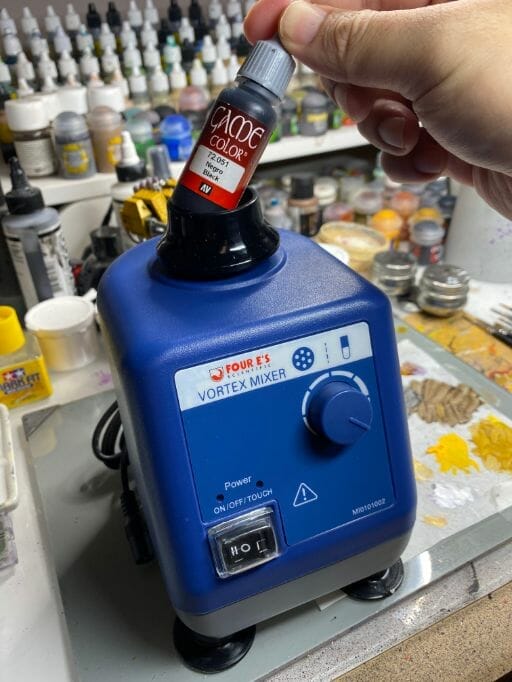
The biggest reason I finally splurged on a big vortex mixer for model paints was that I was sick of shaking my paints. After a good tendonitis-inducing shake, it is quite frustrating to find that the bottle didn’t mix well enough.
READ MORE: 5 POPULAR MODEL PAINT MIXERS REVIEWED
Sure, you can DIY a paint mixer with a jigsaw or a Theragun (I want one of these), but seriously how much more work is that?
If you have a sizeable collection of model paints, then you already know what I’m talking about. Paint separation is a speed bump to what should be the easiest phase of miniature painting: getting your paint from your bottle to your palette in one-piece!
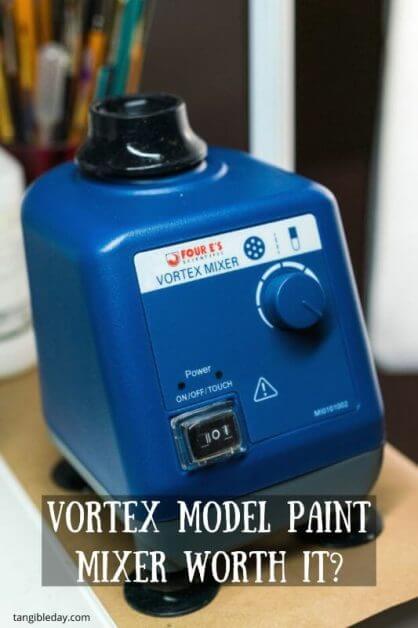
Vortex mixers work well on any model paint brand and bottle size (even the large bottles). I’ve used a vortex mixer to get effect on Army Painter paints, Vallejo dropper bottles, Games Workshop Citadel paint pots, P3 containers with broken caps, Kimera, Pro Acryl paints, and Scalecolor & Scale 75 model paints.
So, is a vortex paint mixer worth it? Yes, 99.9% (see conditions above). Save time, prevent pain, get painting quicker!
How does a vortex model paint mixer work?
Any vortex mixer works the same way. Originally used in laboratories, a vortex mixer has a rotating rubber cup or holder positioned on the top of the device. When you press a test tube or bottle down on the rubber cup, a motor activates inside the vortex mixer and the rubber cup rotates at high speed. The rotational energy from the rubber cup transfers directly into the fluid inside the bottle or test tube and creates a vortex.
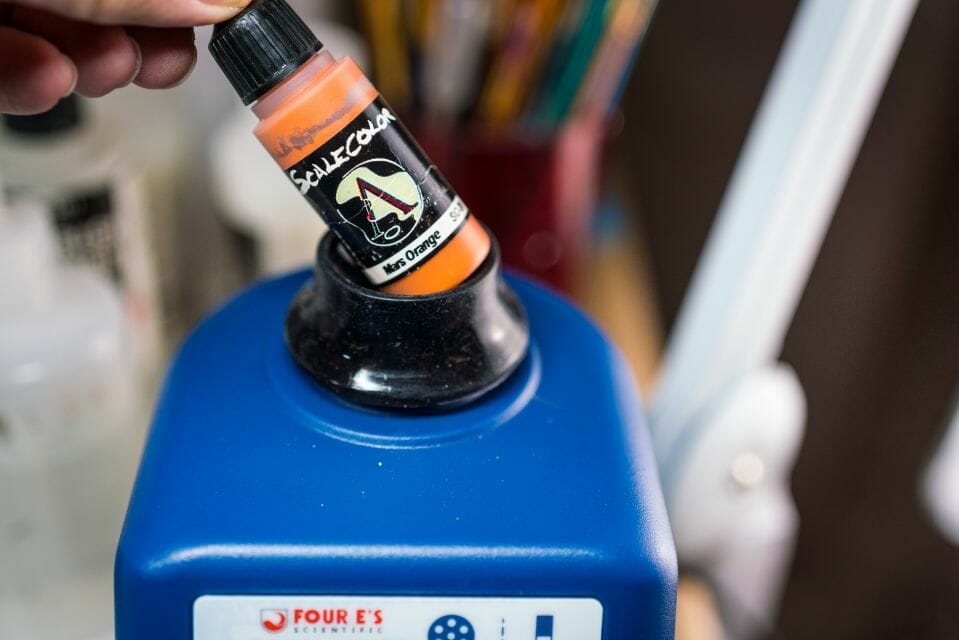
How do you use a vortex model paint mixer, correctly?
The best vortex model paint mixers have “touch-press” operation, which means you don’t need to flip a switch. To operate these vortex mixers, you simply place your bottle into the rubber up and press down. A pressure switch activates the motor and starts the vortex mixer. The oscillating rubber cup’s rotational energy creates a vortexing action inside your model paint bottle.
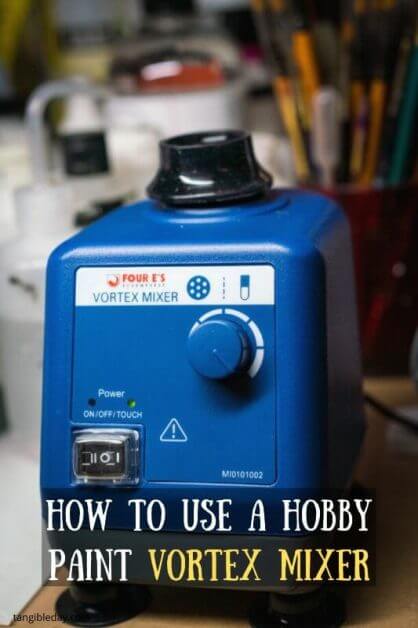
For best results with a vortex mixer, you’ll want to angle your paint bottle in the rubber cup. Placing the corner of your paint bottle into the rubber cup produces the strongest vortexing action inside the bottle. The reason for this is due to the stronger turbulence created by the uneven placement of the bottle in the rubber cup. You want more fluid turbulence for better vortex mixing (see image below below).
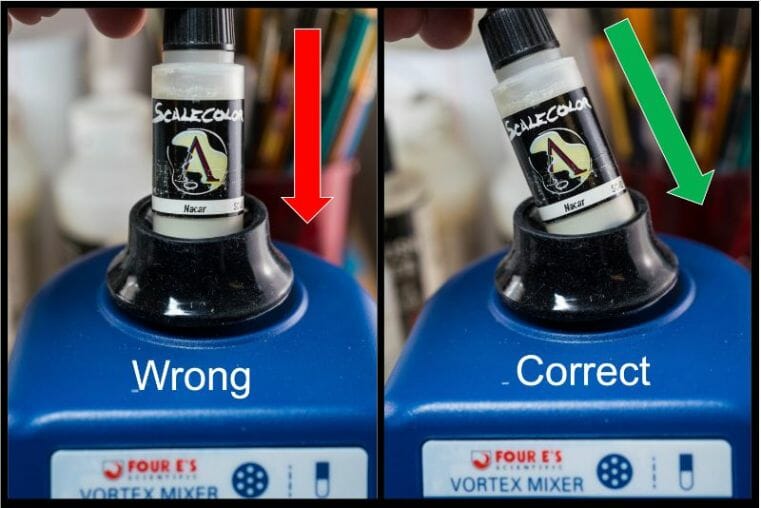
If you use a vortex mixer correctly, then you won’t need agitator balls or other mixing aids inside your paint bottles. Even weaker vortex mixers have sufficient energy transfer to mix thick model paints. Sure, it might take more time, but vortex mixing is really efficient.
Is a vortex mixer hard to use?
Absolutely, not! Vortex mixers are so fast and easy to use that even a child can operate one. And, you can use a vortex mixer with a single hand or a 2 or more fingers! Check out the video and photos below.

Placing the bottle into the rubber cup, all you need is a bit of downward force to activate the motor. The rest is keeping the bottle from flying off the vortex mixer, which is easy on a stable mixer.
For miniature paint mixing, you can set a vortex mixer on its highest setting. Lower speed settings are often reserved for small amounts of fluid in uncapped test tubes. On the Four E’s vortex mixer, there’s a knob that lets you adjust the speed of the rotating rubber cup.
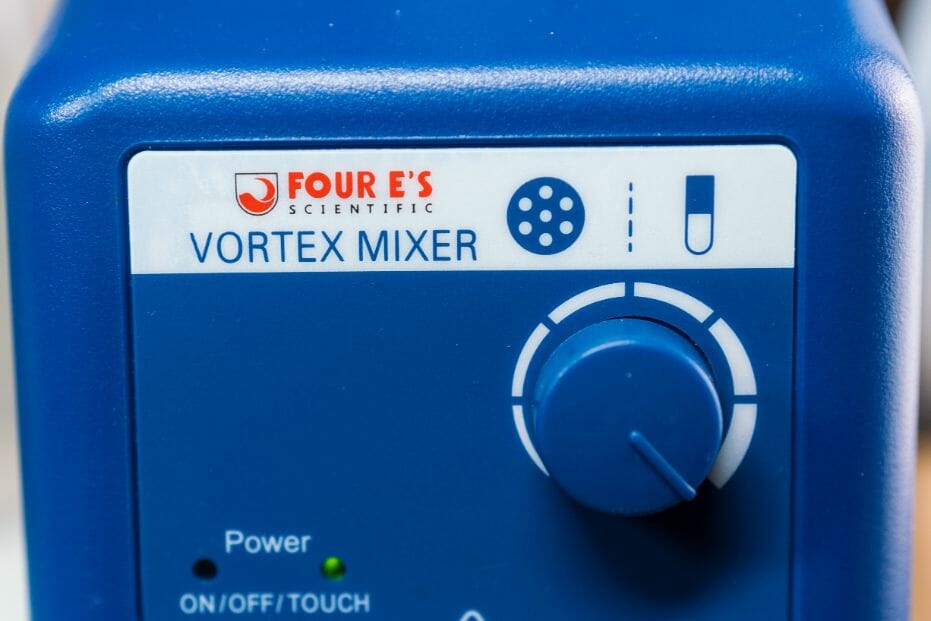
Vortex mixing operation on smaller bottles of hobby paint requires only a few fingers to keep things steady. On larger bottles, you can still use one hand but hold tight as the rotating might throw the bottle off.
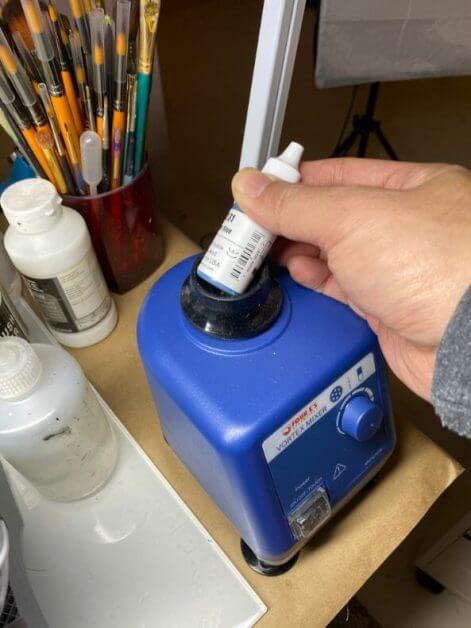
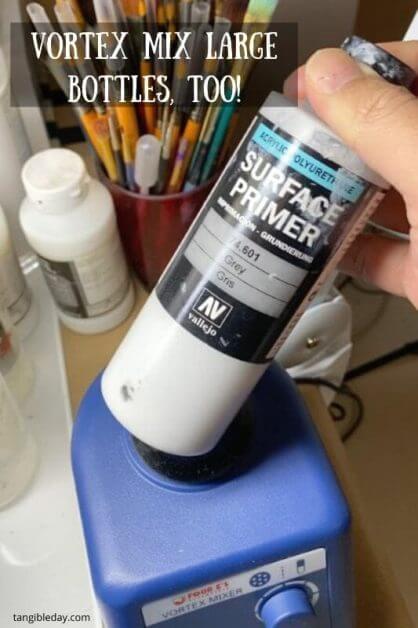
What kind of paints can you mix on a vortex mixer?
I’ve mixed acrylic and oil paints on my vortex mixer. As long as there’s fluid with a viscosity of around maple syrup or thinner, you can vortex mix your paint effectively (e.g., no mixing balls needed). In general, a good vortex mixer will happily mix any hobby model paint.

The bottle shape and size doesn’t matter either. A vortex mixer will work on weirdly shaped bottles, too, e.g., oblong, hexagonal. Just remember to tilt your bottles sideways to create enough turbulence. On larger vortex mixers, you may be able to mix large bottles of paint or primer, as well. On the vortex mixer I review below, I was able to easily mix up 200mL bottles of surface primer in a few seconds.
Bottles like Vallejo Surface Primer and AK Interactive primer (see review for these primers here) may require a good shake before use. Of course, maybe vortexing them is overkill, but fun and fast.
How frequently should you mix or shake up your paints?
The great thing about model paint is that as long as it doesn’t dry out, there is no expiration date. I’ve heard of miniature painters digging up old stashes of model paints, i.e., Citadel, more than a few decades later and happily painting with them after a good stir/mix/shake.
Of course, almost all miniature modeling paint will separate in its bottle if left alone for too long. The only paint brand I know that won’t separate easily are P3 model paints (Privateer Press), and most inks won’t need vigorous mixing.
Overall, depending on the paint brand and formula, paints can separate into its respective acrylic binder and pigment in a matter of hours, days, or weeks. Paint with more dense pigment and low viscosity binder (e.g., thinner paint formula) will seperate faster than higher viscosity paint.
For best results, you should shake and mix most paints immediately before you use them for painting miniatures.
Key 5 features of a good vortex mixer for model paints
Here are 5 key features of vortex mixers you should know for mixing model paints:
- Cost (benefit)
- Size (tabletop footprint)
- Noise level
- Stability
- Speed vs. power
Cost (benefit)
A vortex mixer is an expensive hobby luxury. There is no getting around it, and this is why I bring up the cost of a vortex mixer first. Vortex mixers are industrial and commercial pieces of equipment, intended for professional long-term use. A vortex mixer is designed mainly for laboratory settings where reliability and durability are top priorities for any equipment. They must operate consistently over long periods of time without fail.
Suffice it to say, vortex mixers are not toys. They are like a carpenter’s miter saw or a wedding photographer’s camera lenses. So, relatively speaking, a good vortex mixer is not expensive at all. You are getting what you pay for, a piece of hobby equipment that will run for years, if not decades.
Size (tabletop footprint)
Vortex mixers come in a variety of sizes. Usually, the bigger vortex mixers have more powerful motors. For the miniature painter or modeler, the size matters because of how much space you have on your tabletop. The good news is that most vortex model paint mixers aren’t large. At most, we are talking about a mixer with the desk footprint of a small shoebox.

There are mini vortex paint mixers like the Labgenius mini vortex mixer, which will fit easily in any hobby space and store away compactly, if needed. Other vortex mixers are tall or wide, and house more powerful motors, but will be more cumbersome to operate in tight spaces.
Noise level
Noise level was probably my biggest issue when I lived in my small apartment. Some model paint mixers are loud. If you hobby in a place where loud noise is an issue, e.g., sleeping babies, roommates, or neighbors, then make sure your vortex mixer isn’t a noisy machine. You can hear the noise level of my Four E’s Vortex Mixer in this video.
In general, the heavier the vortex mixer, the quieter it will be. The extra weight of a large vortex mixer helps dampen the vibration noise. On some vortex mixers, there are speed controls that may help lower the overall noise levels as well.
Stability
Think about how a vortex mixer works to shake your model paint. It uses an electric motor to oscillate a rubber cup and your paint. According to Newton’s 3rd law of thermodynamics, for every action, there is an equal and opposite reaction (source).
Bottomline, a vortex mixer is going to experience major shaking and bouncing around if it is too light-weight or unstable. In most tabletop vortex devices, there is no active dampening or counter-weight to the rotating cup. Instead, vortex mixers for most hobbyists will rely on their sheer weight to remain stable during operation.
On some vortexers, you’ll find rubber suction cup feet that can stick to smooth table surfaces. This helps prevent the vortex mixer from bouncing around the tabletop while shaking your paints or other media.
A smaller vortex mixer may not output the same power as a larger vortex mixer due to the fact they are less stable. This also limits smaller vortex mixers to smaller volumes of liquid, including smaller bottles of paint. Be aware of this limitation if you are planning to get a vortex mixer for all of your paint and primer bottles (which may end up being too big for a mini vortexer).
Speed versus power
When choosing a vortex mixer, look for the motor rating input/output power (usually in watts or “W”). The higher the wattage, the more powerful the motor and the better torque it can output into your paint bottles while mixing.
The speed of of the mixer is listed as rotations per minute (or RPM). For the most part, the RPM of a vortex mixer is not as important as power. Any motor can spin fast, if it is geared for speed. But, not every motor can produce the torque necessary to constantly accelerate and spin a heavy weight, e.g., paint or other volume of liquid.
If you have to choose between two vortex mixers of similar price, go for the one that has higher wattage and lower RPMs.
Of course, you will find that a high motor power vortex mixer will be more expensive, but it will allow you to mix higher volumes of paint for longer periods of time. In other words, big motors are designed for heavy duty use and will have much better durability and longer service life.
Full Review of the Four E’s Scientific Vortex Mixer for Model Paint
Here is a real user review of the Four E’s Vortex Mixer Shaker for model paint
Look and feel
The Four E’s Scientific Vortex Mixer Shaker looks like it belongs in any laboratory. For the miniature painter and hobbyist, it has the premium look and feel of something you need to have on your desk. You’ve seen the photos; it stands out.
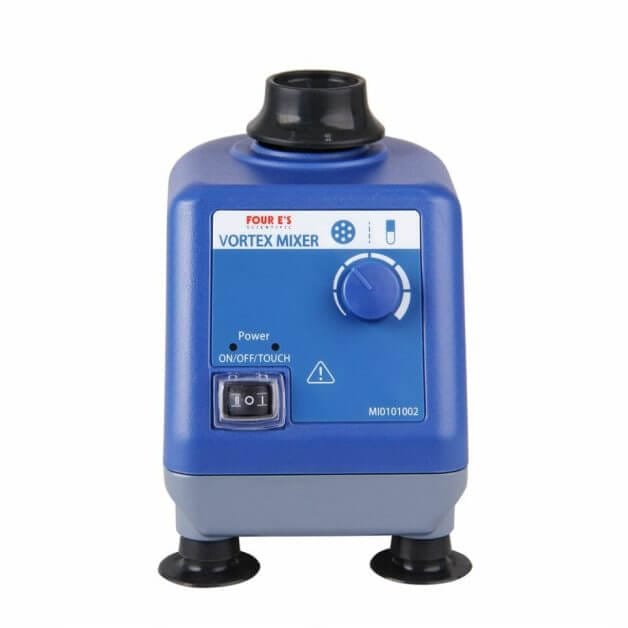
The Four E’ vortexer is a dense piece of equipment. It weighs approximately 7lb or 3.2 kg. For a fun point of reference, the vortex mixer weighs as much as a full gallon (or 3.8 liters) of water. But, it doesn’t take up that much space!
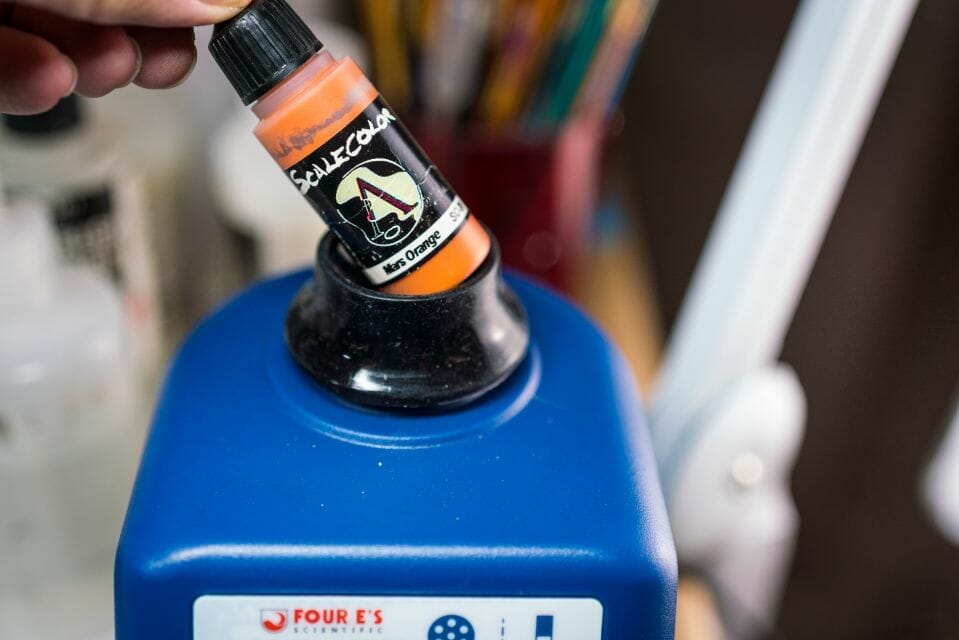
Key features
Overall, the vortex mixer feels amazing to operate. It doesn’t budge when spinning and produces very little noise (check out the videos). The Four E’ vortex mixer I have is simple with only two functions: an on/off/touch switch and a speed adjustment knob (slow to fast).
The on/off/touch switch lets you control how the vortexer activates. You can leave it “on” and the motor will continuously spin. Or, you can use the “touch” setting (recommended), which lets you turn on the vortex mixer by pressing and holding your paint bottle in the rubber cup. The latter is so easy a small child can use the mixer.
Real world use of the model paint vortex mixer
As shown in the example below, paint that separates in its bottle will dispense a clear fluid binder instead of the useful creamy paint color. This blue Reaper paint has separated badly.
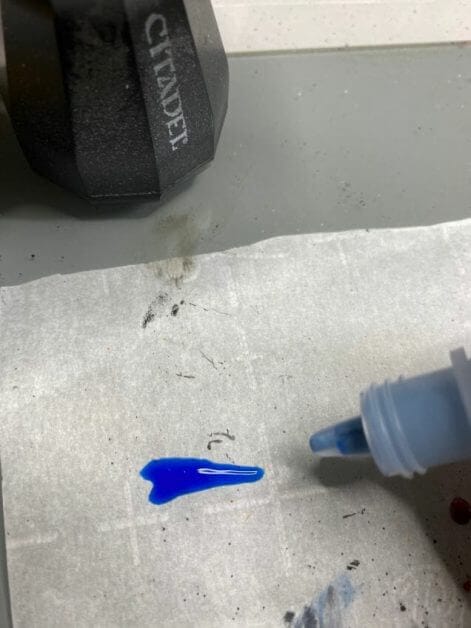
I tested the Four E’s Scientific Laboratory vortex mixer on a lot of different paints at various levels of separation. The worst offenders included Vallejo Game Color, Reaper Master Series, and The Army Painter brand paints. These paints all had badly separated in their bottles. Metallic model paints were also very prone to separation, probably due to the heavier metal “pigment” or flakes in these formulas.
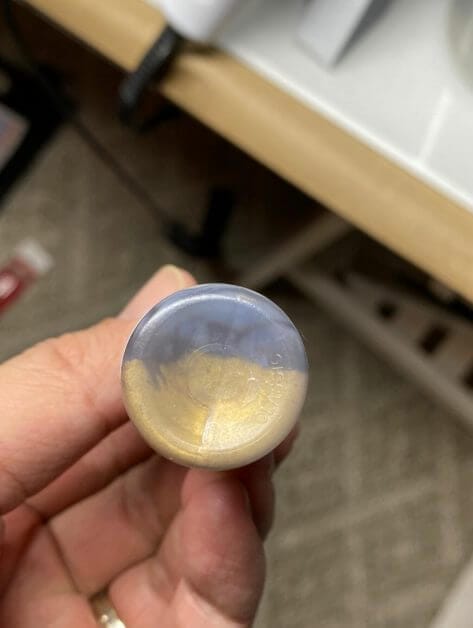
After a quick spin on the vortex mixer, the blue reaper paint mixed right back up and is ready to use. You can see the result before and after vortex mixing the blue reaper miniature paint.
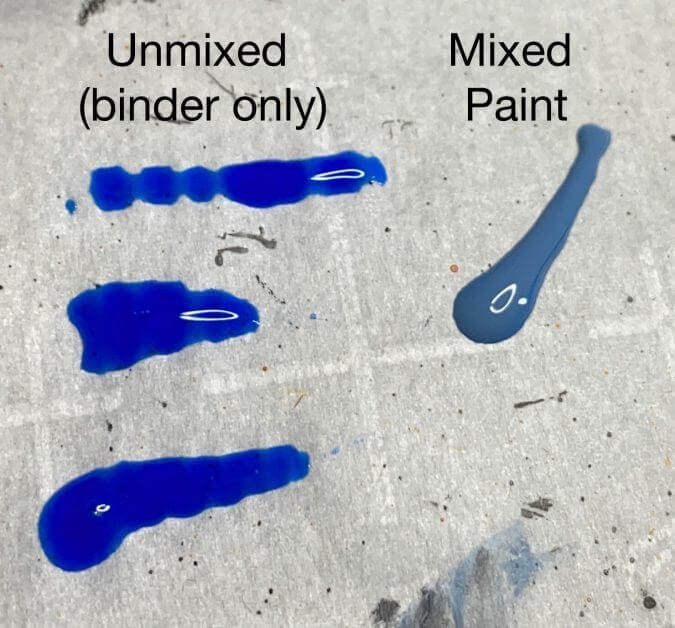
Other observations
The rubber cup on the Four E’s Scientific Vortex Mixer is compatible with all paint pots, bottle shapes and sizes (up to 200ml). Interestingly, I also used the vortex mixer to stir some old 28mm models submerged in isopropyl alcohol. I’m not sure this helped speed up paint stripping, but it looked cool and still worked great!
The rubber feet and weight of the vortex mixer also helped keep it stable during use. No bouncing around while vortex mixing/shaking model paints. Following best use practice with any vortex mixer, I tilted my paint bottles to maximize the turbulence inside the bottle. With this approach, I was able to effectively mix any dropper style and pot of model paint in less than 10 seconds.
Overall, it’s a fantastic device and I’m 100% pleased I splurged on this model.
Here’s a demo video of using the Four E’s vortex mixer for model paint:
Conclusion
And, there you have it: tips for best practice and use of a vortex mixer for model pain and a review of the Four E’s Scientific Vortex Mixer for model paints. What do you think? Worth it?
If you paint miniatures, a vortex mixer is an indispensable tool for more productive output. If you have paints that sit around for a while, but you still need to use them, it’s super refreshing to have a model paint mixer.
I hope this article gave you a few new insights into vortex mixers for miniature painting. I’m always on the lookout for new gadgets to play with in the hobby. If you have any ideas or things you’d like to see, let me know with a comment below!
Until next time, happy paint mixing!


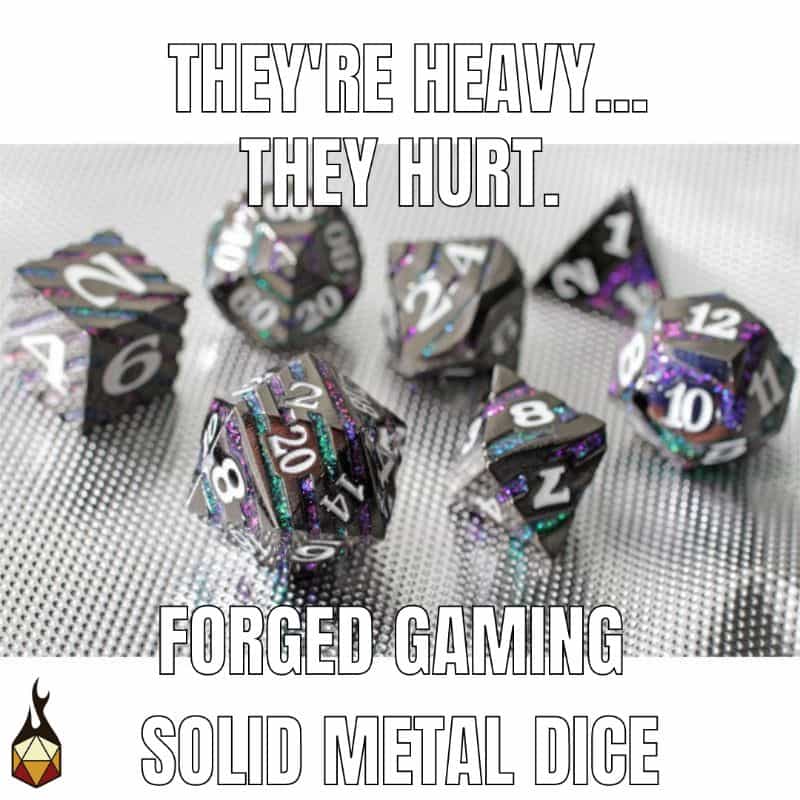


Tangible Day on YouTube (Miniatures and More!)

